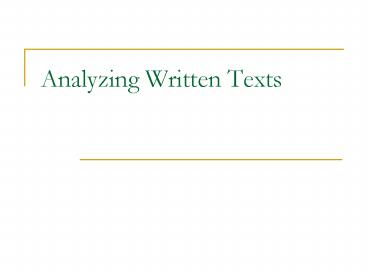Analyzing Written Texts - PowerPoint PPT Presentation
1 / 12
Title:
Analyzing Written Texts
Description:
Etymology: from the Latin word for 'woven,' same root as 'textile' Nearly any interweaving of words, ideas, or expression, including a non-fiction essay ... – PowerPoint PPT presentation
Number of Views:30
Avg rating:3.0/5.0
Title: Analyzing Written Texts
1
Analyzing Written Texts
2
Summary
- Definition Brief version of what a text says
- Purpose Reminds readers of the main points of
the text
3
Components of a Summary
- Authors name and title of text
- Main point of original text (thesis)
- Important ideas that support the thesis
- Key examples and details
- Your own words and select quotes
4
Writing a Summary
- Read the text carefully for understanding
- Re-read and highlight thesis, important ideas,
key examples and details - Put thesis, main ideas, and key examples and
details into your own words - Combine sentences and edit carefully.
5
Definitions
- Analysisseparating into parts in order to
understand the whole - Text
- Etymology from the Latin word for woven, same
root as textile - Nearly any interweaving of words, ideas, or
expression, including a non-fiction essay
6
Analyzing a Text
- Unraveling the strands, breaking into parts
- Understanding what the parts all mean making
connections among them and drawing some
conclusion about the whole text
(inference/interpretation) - Inference or interpretation answers the question,
So what?
7
Explaining Your Analysis
- Presenting your analysis to a reader
- Showing your evidence and persuading your reader
that your analysis is valid, that your
understanding (inference/ interpretation) of the
text is legitimate - SG to persuade the reader to see things your
way, including sharing your point of view on a
non-fiction essay
8
Essay 1 Essay 2
- Online advertisement
- Inference Target market
- Description of topic
- Analysis to support inference (features
presented, language, visuals, etc.) - Details and explanation of connections between
details and inferences
- Non-fiction essay
- Inference Point of view
- Summary of essay
- Analysis to support inference (arguments,
comparisons, evidence, etc.) - Details and explanation of connections between
details and inferences
9
Analysis of Non-Fiction Essays
- Thesis
- Comparisons and Contrasts
- Claims about Cause/Effect
- Classification
- Definitions
- Appeal to Audience
- Examples
- Use of Sources
- Context
- Tone
- Organization
10
Discovering a Point of View
- What is my gut-level, personal reaction to this
essay and what the writer has to say in it? - Do I agree or disagree with the author? Some of
both?
11
- Which arguments, examples, or details seem
particularly effective? Ineffective? - How significant or important are the authors
ideas to us as readers? To society? - How does this essay compare to another?
12
Articulating Your Point of View
- Your thesis statement One sentence that
summarizes your point of view on the essay.































